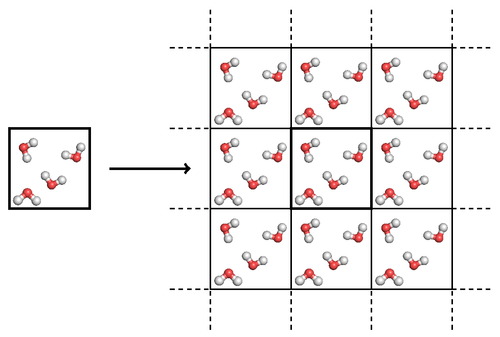In condensed matter simulation periodic boundaries conditions are often used to simulate an infinite system.

Edit and compile if you like:
% Periodic boundaries conditions
% Germain Salvato-Vallverdu - may 2009
% http://germain.salvato-vallverdu.perso.sfr.fr
\documentclass[11pt,a4paper]{article}
\usepackage[utf8]{inputenc}
\usepackage{graphicx}
\usepackage{tikz}
\usepackage[active,tightpage]{preview}
\PreviewEnvironment{tikzpicture}
\setlength\PreviewBorder{5pt}%
\title{Periodic boundaries conditions}
\author{Germain Salvato-Vallverdu}
\usepackage{hyperref}
\hypersetup{%
pdfauthor={Germain Salvato-Vallverdu},%
pdftitle={Periodic boundaries conditions},%
pdfkeywords={Tikz,latex,Periodic boundaries conditions,simulation},%
pdfcreator={PDFLaTeX},%
pdfproducer={PDFLaTeX},%
}
\pagestyle{empty}
\begin{document}
\begin{center}
\begin{tikzpicture}
% water molecule in the initial simulation box
\path (0.45,3.3) node {\includegraphics[width=0.75cm]{img/wat}}
(1.6,4.4) node {\includegraphics[width=0.75cm]{img/wat3}}
(0.5,4.45) node {\includegraphics[width=0.75cm]{img/wat2}}
(1.1,3.7) node {\includegraphics[width=0.75cm]{img/wat4}};
% edge of the initial simulation box
\path[draw,ultra thick] (0,3) rectangle (2,5);
% periodic boundaries
\foreach \x in {5,7,9} {
\foreach \y in {1,3,5} {
% water molecules in images
\node at (\x+0.45,\y+0.3) {\includegraphics[width=0.75cm]{img/wat}};
\node at (\x+1.6 ,\y+1.4) {\includegraphics[width=0.75cm]{img/wat3}};
\node at (\x+0.5 ,\y+1.45) {\includegraphics[width=0.75cm]{img/wat2}};
\node at (\x+1.1 ,\y+0.7) {\includegraphics[width=0.75cm]{img/wat4}};
% edge of each box
\path[draw,thick] (\x,\y) rectangle (\x+2,\y+2);
}
}
% central box thicker than other
\path[draw,ultra thick] (7,3) rectangle (9,5);
% an arrow
\path[draw,ultra thick,->] (2.5,4) -- (4.5,4);
% dashed lines
\foreach \x in {5,7,9,11} {
% vertical
\path[draw,dashed,thick] (\x,0) -- (\x,1) (\x,7) -- (\x,8);
% horizontal
\path[draw,dashed,thick] (4,\x-4) -- (5,\x-4) (11,\x-4) -- (12,\x-4);
}
\end{tikzpicture}
\end{center}
\end{document}Click to download: periodic-boundaries-conditions.tex • periodic-boundaries-conditions.pdf
Open in Overleaf: periodic-boundaries-conditions.tex


